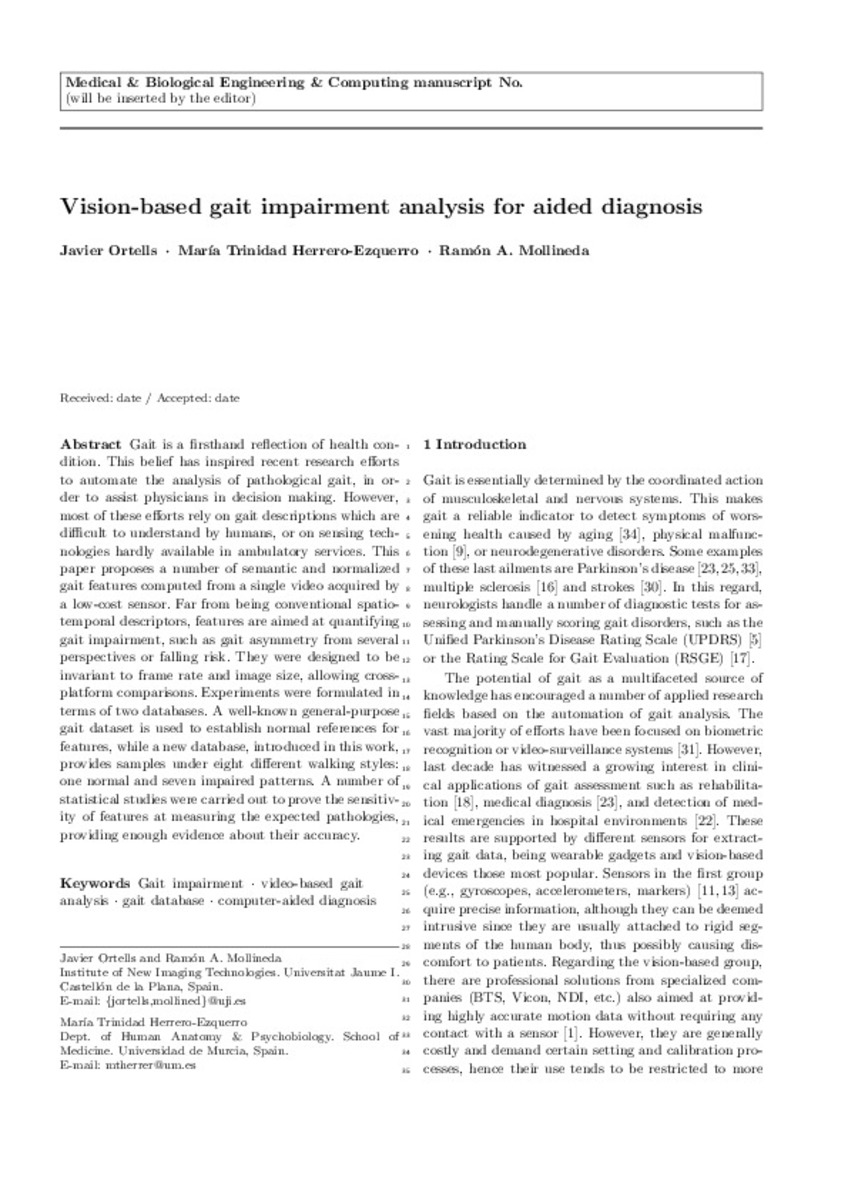Mostrar el registro sencillo del ítem
Vision-based gait impairment analysis for aided diagnosis
| dc.contributor.author | Ortells Lorenzo, Javier | |
| dc.contributor.author | Herrero Ezquerro, María Trinidad | |
| dc.contributor.author | Mollineda, Ramón A. | |
| dc.date.accessioned | 2018-05-29T09:25:06Z | |
| dc.date.available | 2018-05-29T09:25:06Z | |
| dc.date.issued | 2018 | |
| dc.identifier.citation | Ortells, J., Herrero-Ezquerro, M.T. & Mollineda, R.A. Med Biol Eng Comput (2018). https://doi.org/10.1007/s11517-018-1795-2 | ca_CA |
| dc.identifier.issn | 0140-0118 | |
| dc.identifier.issn | 1741-0444 | |
| dc.identifier.uri | http://hdl.handle.net/10234/174854 | |
| dc.description.abstract | Gait is a firsthand reflection of health condition. This belief has inspired recent research efforts to automate the analysis of pathological gait, in order to assist physicians in decision-making. However, most of these efforts rely on gait descriptions which are difficult to understand by humans, or on sensing technologies hardly available in ambulatory services. This paper proposes a number of semantic and normalized gait features computed from a single video acquired by a low-cost sensor. Far from being conventional spatio-temporal descriptors, features are aimed at quantifying gait impairment, such as gait asymmetry from several perspectives or falling risk. They were designed to be invariant to frame rate and image size, allowing cross-platform comparisons. Experiments were formulated in terms of two databases. A well-known generalpurpose gait dataset is used to establish normal references for features, while a new database, introduced in this work, provides samples under eight different walking styles: one normal and seven impaired patterns. A number of statistical studies were carried out to prove the sensitivity of features at measuring the expected pathologies, providing enough evidence about their accuracy. | ca_CA |
| dc.format.extent | 13 p. | ca_CA |
| dc.format.mimetype | application/pdf | ca_CA |
| dc.language.iso | eng | ca_CA |
| dc.publisher | Springer Verlag | ca_CA |
| dc.relation.isPartOf | Med Biol Eng Comput (2018) | ca_CA |
| dc.rights | “This is a post-peer-review, pre-copyedit version of an article published in Medical and Biological Engineering and Computing. The final authenticated version is available online at: http://dx.doi.org/10.1007/s11517-018-1795-2.” © International Federation for Medical and Biological Engineering 2018 | ca_CA |
| dc.rights.uri | http://rightsstatements.org/vocab/InC/1.0/ | * |
| dc.subject | Gait impairment | ca_CA |
| dc.subject | Video-based gait analysis | ca_CA |
| dc.subject | Gait database | ca_CA |
| dc.subject | Computer-aided diagnosis | ca_CA |
| dc.title | Vision-based gait impairment analysis for aided diagnosis | ca_CA |
| dc.type | info:eu-repo/semantics/article | ca_CA |
| dc.identifier.doi | https://doi.org/10.1007/s11517-018-1795-2 | |
| dc.rights.accessRights | info:eu-repo/semantics/openAccess | ca_CA |
| dc.relation.publisherVersion | https://link.springer.com/article/10.1007/s11517-018-1795-2 | ca_CA |
| dc.date.embargoEndDate | 2019-02-13 | |
| dc.type.version | info:eu-repo/semantics/acceptedVersion | ca_CA |
Ficheros en el ítem
Este ítem aparece en la(s) siguiente(s) colección(ones)
-
INIT_Articles [747]







